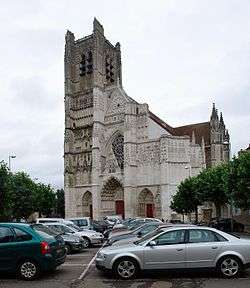Roman Catholic Diocese of Auxerre
The bishopric of Auxerre (Lat. dioecesis Autissiodorensis) is a former French Roman Catholic diocese. Its historical episcopal see was in the city of Auxerre in Burgundy, now part of eastern France. Currently the non-metropolitan Archbishop of Sens, ordinary of the diocese of Sens and Auxerre, resides in Auxerre.
Ecclesiastical history
The Gestes des évêques d'Auxerre, written about 875 by the canons Rainogala and Alagus, and continued later down to 1278, gives a list of bishops which, save for one detail, Louis Duchesne regards as accurate; but the chronological data of the Gestes ('deeds') seem to him to be very arbitrary for the period prior to the 7th century. No other church of France glories in a similar list of bishops honoured as saints; already in the Middle Ages this multiplicity of saints was remarkable.
To 1000
St. Peregrinus (Pélérin 'pilgrim') was the founder of the see; according to the legend, he was sent by pope Sixtus II and was martyred under Emperor Diocletian in 303 or 304.
After him are mentioned without the possibility of certainly fixing their dates:
- St. Marcellianus
- Valerianus
- St. Helladius
- St. Amator (d. 418), who had been ordained deacon and tonsured by St. Helladius and who thus affords the earliest example of ecclesiastical tonsure mentioned in the religious history of France
- St. Germain d'Auxerre (418–448), to whom the abbey in Auxerre is dedicated
- St. Allodius
- St. Fratemus
- St. Censurius, to whom about 475 the priest Constantius sent the Life of St. Germain
- St. Ursus
- St. Theodosius, who assisted in 511 at the First Council of Orléans
- St. Gregorius
- St. Optatus
- St. Droctoaldus
- St. Eleutherius, who assisted at four Councils of Orléans between 533 and 549
- St. Romanus
- St. Actherius
- St. Aunacharius (Aunaire; 573–605), uncle of St. Lupus, Archbishop of Sens who held the Council of Auxerre which illustrated the customs among both the newly converted Teutonic tribes and their Gallo-Roman neighbours
- St. Desiderius (Didier)
- St. Palladius, who assisted at several councils in 627, 650 and 654
- St. Vigilius, who was assassinated about 684, doubtless at the instigation of Gistemar, son of Waratton, mayor of the palace
- St. Tetricius (692–707)
- Savaric (710–715)
- Aidulf (perhaps 751–766)
- Maurin (perhaps 766–794)
- Blessed Aaron (perhaps 794–807)
- Blessed Angelelmus (807–828)
- St. Heribaldus (829–857), first chaplain of Louis the Pious, and several times given ambassadorial charges
- St. Abbo (857–869)
- Blessed Christian (860–871)
- Wibaldus (879–887)
- Herifridus (Herfroy; 887–909)
- St. Géran (909–914)
- St. Betto (933–961)
- Guy (933–961)
- Heribert I (971-996)
- John (996–999)
- Hugh of Chalon (999–1030)
From 1000
- Heribert II (1039-1052)
- Geoffrey of Champallemand (1052-1076)
- Robert of Nevers (1076-1092)
- Humbaud (1095–1114), drowned on the way to Jerusalem
- St. Hugues de Montaigu (1116–1136), a friend of St. Bernard
- Hugues de Mâcon (1137–1151), Abbot of Pontigny, often charged by Pope Eugenius III with adjusting differences and re-establishing order in monasteries
- Alanus (1152–1167), author of a life of St. Bernard
- Guillaume de Toucy (1167–1181), the first French bishop who went to Rome to acknowledge the authority of Pope Alexander III.
Among later bishops may be mentioned:
- Hugues de Noyers (1183–1206), known as the "hammer of heretics" for the vigour with which he sought out in his diocese the sects of the Albigenses and the "Caputiés" (mainly in Sens)
- Guillaume de Seignelay (1207–1220), who took part in the war against the Albigenses and in 1230 became the bishop of Paris
- Henry of Villeneuve (1220–1235)
- Bernard de Sully (1235–1244)
- Guy de Mello (1247–1270), who was Apostolic delegate in the crusade of Charles of Anjou against Manfred
- Pierre de Mornay (1296–1306), who negotiated between Pope Boniface VIII and king Philip IV and in 1304 became chancellor of France
- Pierre de Cros (1349–1351), cardinal in 1350
- Pierre de Longueil (1449–1474)
- Enguerrand Signart (1474–1477)
- John III Baillet (1477–1513)
- François de Dinteville (1513–1530)
- Philippe de Lenoncourt (1560–1562), cardinal in 1586
- Philibert Babou de la Bourdaisière (1562–1570), cardinal in 1561
- Jacques Amyot the scholar (1571–1593), translator of the works of Plutarch and Diodorus Siculus, tutor of Charles IX, grand almoner of kings Charles IX and Henry III
- Charles de Caylus (1704–1754), who made his diocese a centre of Jansenism and whose works in four volumes were condemned by Rome in 1754.
On November 29, 1801, the bishopric was suppressed. On October 7, 1817, it was restored, but in 1821 it was suppressed again. On June 3, 1823, it was united (having no separate titular bishop) to the diocese (soon after archbishopric again) of Sens, which in turn lost its Metropolitan status in 2006 and became part of the Ecclesiastical Province of the archbishopric of Dijon.
The Cathedral of Auxerre, completed in 1178, contains numerous sculptures in the Byzantine style.
References
Bibliography
- Gams, Pius Bonifatius (1873). Series episcoporum Ecclesiae catholicae: quotquot innotuerunt a beato Petro apostolo. Ratisbon: Typis et Sumptibus Georgii Josephi Manz.
- Eubel, Conradus (ed.) (1913). Hierarchia catholica, Tomus 1 (second ed.). Münster: Libreria Regensbergiana.CS1 maint: extra text: authors list (link) pp. 72–73. (in Latin)
- Eubel, Conradus (ed.) (1914). Hierarchia catholica, Tomus 2 (second ed.). Münster: Libreria Regensbergiana.CS1 maint: extra text: authors list (link) pp. 80–81.
- Eubel, Conradus (ed.); Gulik, Guilelmus (1923). Hierarchia catholica, Tomus 3 (second ed.). Münster: Libreria Regensbergiana.CS1 maint: extra text: authors list (link) pp. 95–96.
- Gauchat, Patritius (Patrice) (1935). Hierarchia catholica IV (1592-1667). Münster: Libraria Regensbergiana. Retrieved 2016-07-06. p. 70.
- Ritzler, Remigius; Sefrin, Pirminus (1952). Hierarchia catholica medii et recentis aevi V (1667-1730). Patavii: Messagero di S. Antonio. Retrieved 2016-07-06. p. 70.
- Ritzler, Remigius; Sefrin, Pirminus (1958). Hierarchia catholica medii et recentis aevi VI (1730-1799). Patavii: Messagero di S. Antonio. Retrieved 2016-07-06. p. 67.
External links

- GigaCatholic- Sens & Auxerre
